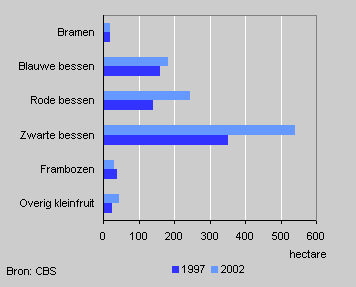Fruit farming: smaller areas, younger plants

Fruit growers have rejuvenated their orchards in the last five years, while the total area of fruit cultivation shrank from 23 thousand hectares in 1997 to 20 thousand hectares in 2002.
Fewer apples
The decrease in fruit cultivation is completely accounted for by a reduction in the area of apple trees. This has decreased by four thousand hectares since 1997, partly a result of the relatively low prices in recent years.
Fruit growers have rejuvenated their orchards though. The area of apple trees younger than five years has risen from 3,600 to 4,100 hectares, i.e. from 24 to 37 percent of the total area. The apple variety Elstar, in particular, was widely planted.
Area of fruit trees younger than 5 years

Slightly more pears
Pear orchards have gained territory in the last five years, by 300 hectares to 6,300 hectares. The area of pear trees younger than 5 years rose by 15 percent to 1,500 hectares. The variety Conference has become considerably more popular in the last five years than Doyenné du Comice.
More cooling capacity and more sprinkling
The cooling capacity of apple and pear growers rose from 15 to 18 thousand kg per hectare. The fruit is kept in cool storage after picking so that it can be sold later on in the season. The area of apple and pear trees that can be protected from night frost with a sprinkling system has also increased, to just over fifty percent of the total area.
Soft fruit

More red and black currants
For soft fruit, the increase in the area of red currants (+ 70 percent) and black currants (+ 50 percent) is most noticeable. The cultivation of red currants is intensive and small scale, with an average 0.8 hectare per grower. Black currants, on the other hand are grown more extensively and on a larger scale, with an average 7 hectares per grower.
Reinoud Segers